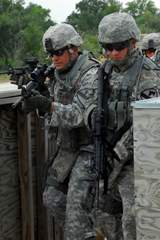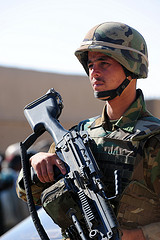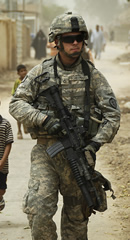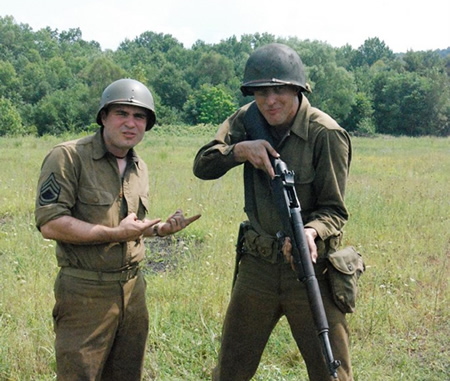WWII G.I. Weapon Carrying Methods
Published: August 30, 2010
Author & Researcher: Charles McFarlane
Contributor & Editor: Mike Ellis
This article is dedicated to Bill Ford-
Thank you for correcting me with my rifle way back when and being the guiding light of the anti low ready movement, without you this article would have never been.Background:
We’ve all seen it, and maybe we have done it before. The reenactor in a perfect kit, lock bar sight for his M1 with single slot gas plug - the whole shebang - but he's carrying his rifle like he's knocking down doors in Baghdad, not liberating occupied France. This is no ones fault; its just the weapon carrying culture we are in. Be it an active duty military member or a run of the mill reenactor who saw it on TV, a modern "tactical" carry is one of those little things that can kill an impression.
Still not sure what I'm talking about? It's called the "low ready", the current US Army standard for weapons handling. Take a look at the below images - the "low ready" is characterized by the near vertical rifle, buttstock atop the shoulder, muzzle pointed towards the dirt. It was developed as a safer way to carry the M16 - obviously this puts it decades after the war ended.
I understand that some people really do not take notice of how they carry their weapon, because it has never been mentioned to them before. This article should help them become more aware. The other reason I have heard for not carrying their weapon correctly is that some reenactors view the "low ready" safer then the GI methods. No weapon carrying technique is safe if the individual has their finger on the trigger and the safety is off. If you follow those two staple rules you will find most historical methods as safe as any modern equivalent.
GIs are often compared to snowflakes, thus it's impossible to say that any particular method is THE authentic way GIs carried their rifles. The purpose of this article is to demonstrate the multitude of historical alternatives to the modern "low ready" carry. For brevity, I have classified the most common techniques for easy reference.
The images are separated into three sections:
Section I: How They Were Taught. These images cover citizen Soldiers in training, some holding a rifle for the first time, some not.
Section II: Theatre Maneuvering and Combat Situations. This is a look at GIs in a tactical setting, where combat experience required new methods.
Section III: Non Combat. This is the most relevant for reenactors, with group shots and posed pictures showing GIs in relaxed situations.
90th IDPG Articles






